|
|
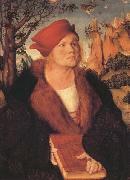 |
Lucas Cranach the Elder
|
|
b. 1472, Kronach, d. 1553, Weimar. German painter and printmaker. He took his name from the town of his birth. Little is known about his early life or training. In Vienna (c. 1501 ?C 04) he painted some notable portraits and landscapes characteristic of the Danube school. From 1505 to 1550 he was court painter in Wittenberg, where he achieved great success and wealth painting portraits, mythological subjects, and altarpieces for Protestant and Catholic churches. He attracted so many young artists to Wittenberg that the town became an art centre. A friend of Martin Luther, Cranach became known as the chief pictorial propagandist of the Protestant cause in Germany. He produced numerous engravings and more than 100 woodcuts, notably for the first German edition of the New Testament (1522). After his death, his style was perpetuated by his son, Lucas the Younger (1515 C 86). |
|
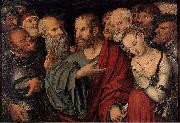 |
Lucas Cranach the Younger
|
|
(October 4, 1515 ?C January 25, 1586) was a German Renaissance artist, known for his woodcuts and paintings.
He was a son of Lucas Cranach the Elder who began his career as an apprentice in his father's workshop. Henceforth, his own reputation and fame grew. After his father's death, he assumed control over the workshop.
The style of their paintings can be so similar that there have been some difficulties in attribution of their works. |
|
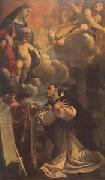 |
Ludovico Carracci
|
|
(Bologna 1555-1619)
Painter, draughtsman and etcher. His father, Vincenzo Carracci, was a butcher, whose profession may be alluded to in Ludovico's nickname 'il Bue', though this might also be a reference to the artist's own slowness. Ludovico's style was less classical than that of his younger cousins Agostino and Annibale, perhaps because of a mystical turn of mind that gave his figures a sense of other-worldliness. Like his cousins, he espoused the direct study of nature, especially through figure drawing, and was inspired by the paintings of Correggio and the Venetians. However, there survives in his work, more than in that of his cousins, a residue of the Mannerist style that had dominated Bolognese painting for most of the mid-16th century. Ludovico maintained a balance between this Mannerist matrix, his innate religious piety and the naturalism of the work of his cousins. With the exception of some travels during his training and a brief visit to Rome in 1602, Ludovico's career was spent almost entirely in Bologna. |
|
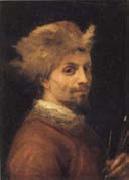 |
Ludovico Cigoli
|
|
Italian Baroque Era Painter ,
1559-1613
was an Italian painter and architect of the late Mannerist and early Baroque period, trained and active in his early career in Florence, and spending the last nine years of his life in Rome. Lodovico Cardi was born at Villa Castelvecchio di Cigoli, in Tuscany, whence the name by which he is commonly known. Initially, Cigoli trained in Florence under the fervid mannerist Alessandro Allori. Later, influenced by the most prominent of the Contra-Maniera painters, Santi di Tito, as well as by Barocci, Cigoli shed the shackles of mannerism and infused his later paintings with an expressionism often lacking from 16th century Florentine painting. For example, for the Roman patron, Massimo Massimi, he painted an Ecce Homo (now in Palazzo Pitti). Supposedly unbenknownst to any of the painters, two other prominent contemporary painters, Passignano and Caravaggio, had been requested canvases on the same theme. It is unclear if they are completely independent. Cigoli's painting seems to have been made with knowledge of Caravaggio's canvas; however, while Cigoli's work lacks the power of Caravaggio's naturalism, the background shade and sparse foreground shows how much he was moving away from crowded Florentine historical paintings. This work was afterwards taken by Bonaparte to the Louvre, and was restored to Florence in 1815. One of his early paintings was of Cain slaying Abel. |
|
|
|
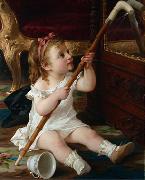 |
Luigi Crosio
|
|
(1835-1915) was an Italian painter who lived and worked in Turin, Italy. He died in Turin and is recorded as having been born in Alba, but the town of Aqua a few miles north of Alba claims Crosio was born there.
He attended the Accademia Albertina di Belle Arte in Turin. His immediate work afterwards tilted towards commercial paintings, but thereafter he specialised in genre painting with romantic 18th century scenes and portraits or period characters or Pompeian scenes. He also liked the opera and depicted several scenes from popular operas. He was also listed as a lithographer and was involved in publishing books and images.
He had several daughters and one of them, Carola Crosio, married the famous mathematician Giuseppe Peano (of Peano axioms fame) in 1887.
In 1898 he painted the famous Refugium Peccatorum Madonna (i.e. Refuge of Sinners Madonna) which was later also called Mother Thrice Admirable Madonna. |
|
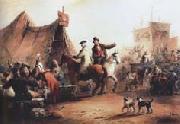 |
Luke Clennell
|
|
Born, 1781, Back. Died, 1840, Country, England
was an English engraver and painter. Born in Morpeth, Northumberland, the son of a farmer, he was apprenticed to the engraver Thomas Bewick in 1797. Between 1799 and 1803 he acted as Bewick's principal assistant on the second volume of the History of British Birds. After completing his seven-year apprenticeship with Bewick he moved to London, where he married a daughter of the copper-engraver Charles Turner Warren (1762-1823). Through his marriage he became acquainted with such book illustrators as William Finden and Abraham Raimbach. He gained a reputation as an engraver and in May 1806 he was awarded the gold palette of the Society of Arts for a wood-engraving of a battle scene. He subsequently gave up engraving for painting. In 1814 he received from the Earl of Bridgewater a commission for a large picture to commemorate the banquet given to the Allied Sovereigns at the Guildhall, London. He experienced great difficulty in getting the distinguished guests to sit for their portraits, and suffered a mental breakdown. After a spell in an asylum, he recovered and returned home. |
|
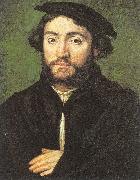 |
Lyon, Corneille de
|
|
Dutch practicing in France, approx. 1500-1575
Dutch painter, active in France. It is uncertain whether he was apprenticed in his native city of The Hague or in Antwerp, and nothing is known of him before 1533, when he was recorded in Lyon. It was possibly in the same year, while the French court was resident in Lyon, that Corneille was made painter to Queen Eleanor, the second wife of Francis I. In 1541 Corneille was painter to the Dauphin (later Henry II), and when the new king succeeded to the throne (1547) and made his state entry into Lyon in 1548, Corneille became Peintre du Roi. Corneille had obtained his naturalization papers in December 1547 and retained French nationality for the rest of his life. He married Marguerite Fradin, the daughter of a Lyon printer of some importance, and this allowed him to enter Lyon society. His studio was extremely prosperous until c. 1565, the year he is known to have visited Antwerp, but disappeared completely after his death despite the fact that he founded a dynasty of painters. His sons Corneille de La Haye II (b 1543) and Jacques de La Haye and his daughter Cl?mence de La Haye were all painters, and the family continued to be known for its artists until the 18th century. Corneille de Lyon was a Protestant, like all those in the circles in which he moved, and it may be that the decline of his fortunes in the 1560s was precipitated by the reversion of Lyon to the Catholic faction |
|
|
|
|
|
|
|
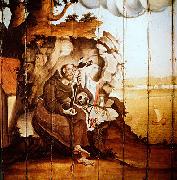 |
Manuel da Costa Ataide
|
|
(1762 to 1830), was a Brazilian painter, sculptor, gilder and teacher.
He was an important artist of the baroque school in Minas Gerais and had a major influence on painting in the region, with many students and followers. His method of composition, particularly in perspective works on church ceilings, continued to be used until the middle of the nineteenth century. Contemporary documents often refer to him as a teacher of painting. In 1818 Ataede tried without success to obtain official permission to found an art school in Mariana, his home town. He owned technical manuals and theoretical tracts such as Andrea Pozzo's "Perspectivae Pictorum Architectorum" from which he must have studied technique.
His art is characterised by the use of bright colours, especially blue.
He was a contemporary and colleague of Antonio Francisco Lisboa (Aleijadinho). In the period 1781 to 1818 he completed and gilded Aleijadinhoes images for the Sanctuary of Bom Jesus de Matosinhos in Congonhas.
|
|
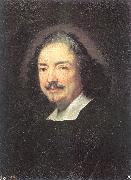 |
Maratta, Carlo
|
|
Italian Baroque Era Painter, 1625-1713
was an Italian painter of the High Baroque period, active mostly in Rome. Born in Camerano, then part of the Papal States. He came as a boy of 12 to apprentice in the studio of Andrea Sacchi. Like Sacchi, his paintings have a classicizing tone, inspired by the works of the great painters from Parma and Bologna: Carracci, Guercino, and Lanfranco. He developed a close relationship with Sacchi till the death of his master in 1661. He worked alongside Francesco Cozza, and Domenico Maria Canuti in the decoration of the Palazzo Altieri. His first prominent work is an Adoration of the Shepherds for San Giuseppe die Falegnami in 1650. He came to establish one of the most prominent art studios in Rome of his time. Other major works are the The Mystery of the Trinity Revealed to St. Augustine (c. 1655) painted for the church of Santa Maria dei Sette Dolori, The Appearance of the Virgin to St. Philip Neri (c. 1675) now in the Pitti Palace of Florence, The Virgin with Saints Carlo Borromeo and Ignatius of Loyola and Angels (c. 1685) for the church of Santa Maria in Vallicella, and The Assumption of the Virgin with Doctors of the Church (1689) for Santa Maria del Popolo, . His numerous depictions of the Virgin earned him the nickname Carluccio delle Madonne (Little Carlo of the Madonnas). The style of Maratta is a classicized Baroque, more restrained and composed than the styles of Cortona and Carracci, thus more allied to the traditions of Sacchi, Albani, and Reni. He was one of the artists favored by Giovanni Bellori. Maratta was known for his insightful portraiture. In 1650, Maratta was introduced to pope Alexander VII, who commissioned many paintings including one of his greatest works, a painting of Constantine destroying the idols for the Baptistry of the Lateran. This work brought Maratta increased fame in the Vatican, and in 1704 Maratta was knighted by pope Clement XI. Other works include an altarpiece in the San Francesco Saverio Chapel of the Church of the Gesu, in the right transept. In 1679 or 1680, a daughter, Faustina Maratti Zappi was born to Maratta by a mistress, |
|
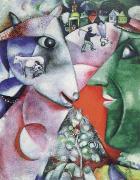 |
marc chagall
|
|
marc chagall(1887 to 1985)French painter, draughtsman, printmaker, designer, sculptor, ceramicist and writer of Belarussian birth. A prolific artist, Chagall excelled in the European tradition of subject painting and distinguished himself as an expressive colourist. His work is noted for its consistent use of folkloric imagery and its sweetness of colour, and it is characterized by a style that, although developed in the years before World War I, underwent little progression throughout his long career. Though he preferred to be known as a Belarussian artist, following his exile from the Soviet Union in 1923 he was recognized as a major figure of the Ecole de Paris, especially in the later 1920s and the 1930s. In his last years he was regarded as a leading artist in stained glass.
|
|
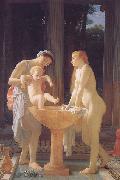 |
Marc Charles Gabriel Gleyre
|
|
Charles Gleyre (full name Marc Gabriel Charles Gleyre) (Chevilly, Vaud canton, 2 May 1806 - 5 May 1874), was a Swiss artist. He took over the studio of Paul Delaroche in 1843 and taught a number of younger artists who became prominent, including Claude Monet, Pierre Auguste Renoir, Alfred Sisley and James Abbott McNeill Whistler.
Self portraitHis father and mother died when he was eight or nine years of age; and he was brought up by an uncle in Lyon, France, who sent him to the industrial school of that city.
Going to Paris in his late teens, he spent four years in intense artistic study. The following four years Gleyre spent in meditative inactivity in Italy, where he became acquainted with Horace Vernet and Louis Leopold Robert; and six years more were spent wandering in Greece, Egypt, Nubia and Syria. At Cairo he was attacked with ophthalmia, or inflammation of the eye, and in Lebanon he was struck down by fever. He returned to Lyons in shattered health.
On his recovery he proceeded to Paris, and, establishing a modest studio in the rue de Universite, began carefully to work out the ideas which had been slowly shaping themselves in his mind. Mention is made of two decorative panels Diana leaving the Bath, and a Young Nubian as almost the first fruits of his genius; but these did not attract public attention until much later, and the painting by which he practically opened his artistic career was the Apocalyptic Vision of St John, sent to the Salon of 1840.
This was followed in 1843 by Evening, which at the time received a medal of the second class, and afterwards became widely popular under the title Lost Illusions. It depicts a poet seated on the bank of a river, with his head drooping and a wearied posture, letting his lyre slip from a careless hand, and gazing sadly at a bright company of maidens whose song is slowly dying from his ear as their boat is borne slowly from his sight.
|
|
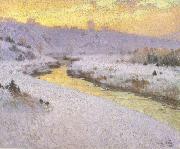 |
marc-aurele de foy suzor-cote
|
|
Canadian Painter, 1869-1937
was a Canadian painter and sculptor. He was born in Arthabaska, Quebec in 1869. He studied at the École des Beaux-Arts in Paris with L??on Bonnat during the 1890s. After his return to Quebec in 1908, he produced many impressionist paintings of the Quebec landscape, as well as portraits, nudes, historical paintings and later sculptures. |
|
|
|
|
|
 |
margareta capsia gavelin
|
|
Margareta Capsia, född 1682 i Sverige, död 20 juni 1759 i Åbo, var en svensk-finländsk konstnär, den första kvinnliga konstnären i Finland och en av de första i Skandinavien. Hon var kyrkomålare och målade altartavlor, men utförde även personporträtt.
Capsias föräldrar Gottfried Capsia och Anna Schultz hade kommit till Sverige från Holland. Hon gifte sig i Stockholm 1719 med prästen Jacob Gavelin och flyttade till Vasa 1721, där hon gjorde sig känd som altarmålare i Österbotten. 1730 flyttade paret till Åbo, där hon blev känd i hela landet som konstnär. Hon målade altatavlorna i en rad kyrkor, bla målade hon 1739 Säkylä kyrkas altartavla, och i den gamla kyrkan i Paltamo, den så kallade bildkyrkan, finns bland annat en altartavla från 1727 som föreställer nattvarden. Hennes altartavlor beskrivs som individualistiska och naivt ärliga bibelillustrationer, och hon ansågs som landets då främsta altarkonstnärer tillsammans med Mikael Toppelius.
Hon var en av de få kvinnliga konstnärerna kända i Skandinavien före 1800-talet, tillsammans med Ulrika Pasch i Sverige och Johanne Marie Fosie i Danmark. I Finland var även Helena Arnell känd under samma tid. |
|
 |
Maria Catharina Wiik
|
|
(b Helsinki, 2 Aug 1853; d Helsinki, 19 June 1928). Finnish painter. She studied in Paris at the Academie Julian from 1875 to 1876 under Tony Robert-Fleury and continued her studies with him in the same studio between 1877 and 1880. Her paintings appeared at the Salon for the first time in 1880 (e.g. Marietta, 1880; Helsinki, priv. col., see Katerma, p. 31). The realist techniques Wiik absorbed in Paris came to form the basis of her work, tranquil in composition and restrained in colour. Her favourite subjects were relatively small-scale portraits such as Hilda Wiik (1881; Helsinki, Athenaeum A. Mus.) and still-lifes (e.g. Still-life, c. 1880; Helsinki, Athenaeum A. Mus.). Like many other foreign painters Wiik went to Brittany to paint. In 1883-4 she worked in Concarneau and Pont-Aven, where her enthusiasm for plein-air painting brought immediacy to her work and greater brightness to her colours (e.g. Breton Farm, 1883; Naantali, Fereningen Hedvigsminne). She preferred to record her impressions in portraits, although she also painted small, light-filled landscapes. In 1889 Wiik worked under the direction of Puvis de Chavannes in Henri Bouvet's studio in Paris, and in the same year she visited St Ives where she painted, among others, two major works: Out in the World (Helsinki, Athenaeum A. Mus.) and the St Ives Girl (Helsinki, priv. col., see Katerma, p. 93). Both works show Wiik moving towards an ever more internalized and minimal mode of expression, thereby taking part in the process that led, in the 1890s, to a general abandonment of realism in favour of a greater emphasis on emotion. Out in the World, which shows an old woman's sad parting from a young girl who is leaving home to begin work, shows a change in technique with the use of more united colour surfaces and of tone painting. (This work was awarded a bronze medal at the Exposition Universelle in Paris in 1900.) During the 1890s and the early 20th century Wiik's travels were concentrated in Scandinavia, although she visited Paris in 1905. |
|
|
|
|
|
|
|
|
|
|
|
 |
Marten van Cleve
|
|
Flemish, 1527-1581,Brother of Hendrik van Cleve III. His presumed date of birth is derived from a document of 2 April 1567 in which he declared his age to be 40. In 1551-2 he became a master in the Antwerp Guild of St Luke and, according to van Mander, followed his brother into the studio of Frans Floris. If this is correct, it was probably c. 1553-5, for motifs drawn from Floris's work appear in Marten van Cleve's paintings executed during these years. Marten married Maria de Greve on 7 January 1556, apparently setting up his own studio at about the same time. Apprentices are regularly recorded from 1558 onwards, and it is probable that his own sons, Gillis II, Marten the younger, Joris and Nicolaas, also worked in the studio. Throughout the 1560s and 1570s Marten van Cleve's workshop was very productive, but the majority of works painted consisted of copies of his own originals. Van Mander's statement that the artist collaborated with a number of landscape painters, including his brother Hendrik III, Gillis van Coninxloo III, Gillis Mostaert and Jacob Grimmer, is confirmed by 17th-century inventories. |
|
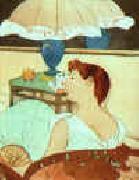 |
Mary Cassatt
|
|
1844-1926
Mary Cassatt Galleries
Within months of her return to Europe in the autumn of 1871, Cassatt??s prospects had brightened. Her painting Two Women Throwing Flowers During Carnival was well received in the Salon of 1872, and was purchased. She attracted much favorable notice in Parma and was supported and encouraged by the art community there: ??All Parma is talking of Miss Cassatt and her picture, and everyone is anxious to know her??.
After completing her commission for the archbishop, Cassatt traveled to Madrid and Seville, where she painted a group of paintings of Spanish subjects, including Spanish Dancer Wearing a Lace Mantilla (1873, in the National Museum of American Art, Smithsonian Institution). In 1874, she made the decision to take up residence in France. She was joined by her sister Lydia who shared an apartment with her. Cassatt continued to express criticism of the politics of the Salon and the conventional taste that prevailed there. She was blunt in her comments, as reported by Sartain, who wrote: ??she is entirely too slashing, snubs all modern art, disdains the Salon pictures of Cabanel, Bonnat, all the names we are used to revere??. Cassatt saw that works by female artists were often dismissed with contempt unless the artist had a friend or protector on the jury, and she would not flirt with jurors to curry favor. Her cynicism grew when one of the two pictures she submitted in 1875 was refused by the jury, only to be accepted the following year after she darkened the background. She had quarrels with Sartain, who thought Cassatt too outspoken and self-centered, and eventually they parted. Out of her distress and self-criticism, Cassatt decided that she needed to move away from genre paintings and onto more fashionable subjects, in order to attract portrait commissions from American socialites abroad, but that attempt bore little fruit at first.
In 1877, both her entries were rejected, and for the first time in seven years she had no works in the Salon. At this low point in her career she was invited by Edgar Degas to show her works with the Impressionists, a group that had begun their own series of independent exhibitions in 1874 with much attendant notoriety. The Impressionists (also known as the ??Independents?? or ??Intransigents??) had no formal manifesto and varied considerably in subject matter and technique. They tended to prefer open air painting and the application of vibrant color in separate strokes with little pre-mixing, which allows the eye to merge the results in an ??impressionistic?? manner. The Impressionists had been receiving the wrath of the critics for several years. Henry Bacon, a friend of the Cassatts, thought that the Impressionists were so radical that they were ??afflicted with some hitherto unknown disease of the eye??. They already had one female member, artist Berthe Morisot, who became Cassatt??s friend and colleague.
Degas, Portrait of Miss Cassatt, Seated, Holding Cards, c. 1876-1878, oil on canvasCassatt admired Degas, whose pastels had made a powerful impression on her when she encountered them in an art dealer's window in 1875. "I used to go and flatten my nose against that window and absorb all I could of his art," she later recalled. "It changed my life. I saw art then as I wanted to see it." She accepted Degas' invitation with enthusiasm, and began preparing paintings for the next Impressionist show, planned for 1878, which (after a postponement because of the World??s Fair) took place on April 10, 1879. She felt comfortable with the Impressionists and joined their cause enthusiastically, declaring: ??we are carrying on a despairing fight & need all our forces??. Unable to attend cafes with them without attracting unfavorable attention, she met with them privately and at exhibitions. She now hoped for commercial success selling paintings to the sophisticated Parisians who preferred the avant-garde. Her style had gained a new spontaneity during the intervening two years. Previously a studio-bound artist, she had adopted the practice of carrying a sketchbook with her while out-of-doors or at the theater, and recording the scenes she saw.
Summertime, c. 1894, oil on canvasIn 1877, Cassatt was joined in Paris by her father and mother, who returned with her sister Lydia. Mary valued their companionship, as neither she nor Lydia had married. Mary had decided early in life that marriage would be incompatible with her career. Lydia, who was frequently painted by her sister, suffered from recurrent bouts of illness, and her death in 1882 left Cassatt temporarily unable to work.
Cassatt??s father insisted that her studio and supplies be covered by her sales, which were still meager. Afraid of having to paint ??potboilers?? to make ends meet, Cassatt applied herself to produce some quality paintings for the next Impressionist exhibition. Three of her most accomplished works from 1878 were Portrait of the Artist (self-portrait), Little Girl in a Blue Armchair, and Reading Le Figaro (portrait of her mother).
Degas had considerable influence on Cassatt. She became extremely proficient in the use of pastels, eventually creating many of her most important works in this medium. Degas also introduced her to etching, of which he was a recognized master. The two worked side-by-side for awhile, and her draftsmanship gained considerable strength under his tutelage. He depicted her in a series of etchings recording their trips to the Louvre. She had strong feelings for him but learned not to expect too much from his fickle and temperamental nature. The sophisticated and well-dressed Degas, then forty-five, was a welcome dinner guest at the Cassatt residence.
The Impressionist exhibit of 1879 was the most successful to date, despite the absence of Renoir, Sisley, Manet and C??zanne, who were attempting once again to gain recognition at the Salon. Through the efforts of Gustave Caillebotte, who organized and underwrote the show, the group made a profit and sold many works, although the criticism continued as harsh as ever. The Revue des Deux Mondes wrote, ??M. Degas and Mlle. Cassatt are, nevertheless, the only artists who distinguish themselves??and who offer some attraction and some excuse in the pretentious show of window dressing and infantile daubing??.
Cassatt displayed eleven works, including La Loge. Although critics claimed that Cassatt??s colors were too bright and that her portraits were too accurate to be flattering to the subjects, her work was not savaged as was Monet's, whose circumstances were the most desperate of all the Impressionists at that time. She used her share of the profits to purchase a work by Degas and one by Monet. She exhibited in the Impressionist Exhibitions that followed in 1880 and 1881, and she remained an active member of the Impressionist circle until 1886. In 1886, Cassatt provided two paintings for the first Impressionist exhibition in the United States, organized by art dealer Paul Durand-Ruel. Her friend Louisine Elder married Harry Havemeyer in 1883, and with Cassatt as advisor, the couple began collecting the Impressionists on a grand scale. Much of their vast collection is now in the Metropolitan Museum of Art in New York City. She also made several portraits of family members during that period, of which Portrait of Alexander Cassatt and His Son Robert Kelso (1885) is one of her best regarded. Cassatt??s style then evolved, and she moved away from Impressionism to a simpler, more straightforward approach. She began to exhibit her works in New York galleries as well. After 1886, Cassatt no longer identified herself with any art movement and experimented with a variety of techniques.
|
|
|
|
|
|
|
|
|
|
|
|
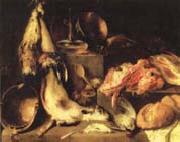 |
Mateo cerezo
|
|
Spanish gifted painter and colorist , c.1626-1666
|
|
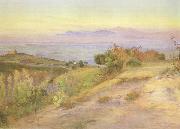 |
Mattew Ridley Corbet,ARA
|
|
1850-1902
was a Victorian neoclassical painter who attended classes at the Slade School of Art under Alexander Davis Cooper and later at the Royal Academy Schools under Frederic Leighton, President of the Academy. Corbet went to Italy in 1880 and met Giovanni Costa, one of Leighton's friends in Rome. For the next three years he stayed and painted with Costa, eventually becoming one of the leading figures of the Macchiaioli school. He concentrated on Italian landscapes and exhibited at the Grosvenor Gallery, the New Gallery, the Royal Academy and the Paris Salon. |
|
|
|
Matthew Ridley Corbet,ARA
|
|
1850-1902
was a Victorian neoclassical painter who attended classes at the Slade School of Art under Alexander Davis Cooper and later at the Royal Academy Schools under Frederic Leighton, President of the Academy. Corbet went to Italy in 1880 and met Giovanni Costa, one of Leighton's friends in Rome. For the next three years he stayed and painted with Costa, eventually becoming one of the leading figures of the Macchiaioli school. He concentrated on Italian landscapes and exhibited at the Grosvenor Gallery, the New Gallery, the Royal Academy and the Paris Salon. |
|
|
|
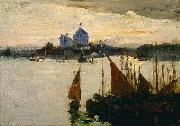 |
Maurice Galbraith Cullen
|
|
Maurice Galbraith Cullen (1866-1934) was a Canadian artist.
Cullen was born June 6, 1866 in St. John's, Newfoundland.
Beginning in January 1918, Cullen served with Canadian forces in the First World War. He came to the attention of Lord Beaverbrook, who arranged for him to be commissioned as an "official war artist" along with Frederick Varley, J.W. Beatty and C. W. Simpson. |
|
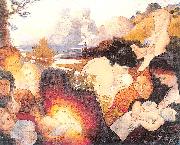 |
Maurin, Charles
|
|
French, 1856-1914
was a French painter who practised a variety of styles. A notable symbolist work of his being Maternity, a study of motherhood. He was a friend of the painter Felix Vallotton. |
|
|
|
 |
Meunier, Constantin
|
|
Belgian Painter and Sculptor, 1831-1905
Belgian sculptor, painter and draughtsman. He was directed towards an artistic career by his elder brother, the engraver Jean-Baptiste Meunier (1821-1900). He entered the Acad?mie des Beaux-Arts, Brussels, in September 1845 and studied under the sculptor Louis Jehotte (1804-84) from 1848. In addition, in 1852 he attended the private studio of the sculptor Charles-Auguste Fraikin. Gradually he came to feel that sculpture, at least in the traditional form taught in Brussels, was incapable of providing an adequate vehicle for either exposition or expression. Still at the Academy, he transferred to painting, therefore, in 1853, and followed the courses given by Fran?ois-Joseph Navez, studying in the evenings at the Saint-Luc studio, with Charles De Groux. He became friends with Louis Dubois, F?licien Rops and other rebellious young artists who were to found the Soci?t? Libre des Beaux-Arts in Brussels in 1868. With these, Meunier was part of the realist avant-garde, while seeking out a path of his own in painting. It has been said that De Groux had a decisive influence on Meunier. The latter partly denied this and insisted that he had felt the need very early to practise an art that was more devoted to the masses, to the people. His interest in everyday life, in the experience and condition of man, can already be discerned in the sketches and studies he made during his stays in the Trappist monastery of Westmalle, near Antwerp, between 1857 and 1875. |
|
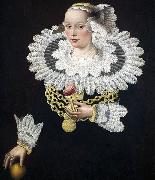 |
Michael Conrad Hirt
|
|
painted Portrait of Anna Rosina Tanck, wife of the mayor of Lubecker in1642 |
|
|
|
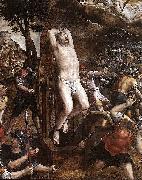 |
Michiel Coxie
|
|
Coxie also spelled Coxcie or Coxien, Latinised name Coxius (1499 - 3 March 1592) was a Flemish painter who studied under Bernard van Orley, who probably induced him to visit the Italian peninsula.
Coxie was born in 1499 in Mechelen in what was then the Duchy of Brabant. At Rome in 1532 he painted the chapel of Cardinal Enckenvoirt in the church of Santa Maria dell'Anima; and Giorgio Vasari, who knew him, says with truth that he fairly acquired the manner of an Italian. But Coxie's principal occupation was designing for engravers; and the fable of Psyche in thirty-two sheets by Agostino Veneziano and the Master of the Die are favorable specimens of his skill.
Returning to the Netherlands, Coxie greatly extended his practice in this branch of art. But his productions were till lately concealed under an interlaced monogram M.C.O.K.X.I.N. In 1539, Coxie returned to Mechelen, where he matriculated and painted the wings of an altarpiece for the chapel of the guild of St Luke. The centre of this altar-piece, by Jan Mabuse, represents Saint Luke the Evangelist, patron of painters, portraying the Virgin; the side pieces contain the Martyrdom of Saint Vitus and the Vision of St John the Evangelist in Patmos.
At van Orley's death in 1541 Coxie succeeded to the office of court painter to the Regent Maria of Austria, for whom he decorated the castle of Binche. He was subsequently patronized by Charles V, Holy Roman Emperor, who often coupled his works with those of Titian; by Philip II of Spain, who paid him royally for a copy of Jan van Eyck's Agnus Dei, and also commissioned two copies of Van der Weyden's Descent from the Cross from Coxie; and by Fernando Álvarez de Toledo, Duke of Alva, who once protected him from the insults of Spanish soldiery at Mechelen. At that time, Coxie also designed tapestries for the Brussels manufacturers. |
|
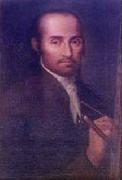 |
Miguel Cabrera
|
|
(1695-1768) was an indigenous Zapotec painter during the Viceroyalty of New Spain, today's Mexico. During his lifetime, he was recognized as the greatest painter in all of New Spain.
He was born in Antequera, today's Oaxaca, Oaxaca, and moved to Mexico City in 1719. He may have studied under the Rodreguez Juerez brothers or Jose de Ibarra.
Cabrera was a favorite painter of the Archbishop and of the Jesuit order, which earned him many commissions. His work was influenced by Bartolome Esteban Murillo and the French painting of his time.
While Miguel is most famous for his Casta paintings and his portrait of the poet Sor Juana, he also executed one of the first portraits of St. Juan Diego. In 1752 he was permitted access to the icon of Our Lady of Guadalupe to make three copies: one for Archbishop Jose Manuel Rubio y Salinas, one for the Pope, and a third to use as a model for further copies. In 1756 he created an important early study of the icon of Our Lady of Guadalupe, Maravilla americana y conjunto de raras maravillas observadas con la direccien de las reglas del arte de la pintura
The essential purpose of Maravilla Americana was to affirm the 1666 opinions of the witnesses who swore that the image of the Virgin was of a miraculous nature. However, he also elaborated a novel opinion: the image was crafted with a unique variety of techniques. He contended that the Virgin's face and hands were painted in oil paint, while her tunic, mandorla, and the cherub at her feet were all painted in egg tempera. Finally, her mantle was executed in gouache. He observed that the golden rays emanating from the Virgin seemed to be of dust that was woven into the very fabric of the canvas, which he asserted was of "a coarse weave of certain threads which we vulgarly call pita," a cloth woven from palm fibers.
In 1753, he founded the second Academy of Painting in Mexico City and served as its director.
|
|
 |
Mikolajus Ciurlionis
|
|
1875-1911 Lithuanian
Mikolajus Ciurlionis Locations
Lithuanian painter and composer. He studied with Noskowski in Warsaw and with Jadassohn and Reinecke at the Leipzig Conservatory (1901). His music makes use of invented modes, colourful harmony and autonomous rhythms; he wrote much for the piano as well as orchestral and chamber music. He was also famous as a painter. |
|
 |
Minerva Josephine Chapman
|
|
(1858 - 1947) was an American painter. She was known for her work in miniature portraiture, landscape, and still life.
She was born in Sand Bank, New York and grew up in Chicago, Illinois. She studied at a number of institutions including Mount Holyoke College (where she graduated from in 1880) and the Art Institute of Chicago. She lived and studied in Paris from the late 1880s to 1915, and again after the first world war, where she established her reputation as an artist. She retired to Palo Alto, California and died at the age of 88.
|
|
|
|
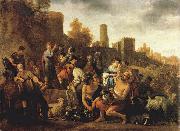 |
MOEYAERT, Claes Cornelisz.
|
|
Dutch painter (b. 1590/91, Durgerdam, d. 1655, Durgerdam)
Dutch painter, etcher and draughtsman. He was the son of an aristocratic Catholic Amsterdam merchant and moved to the city with his family in 1605. He was the most prolific of the history painters now called the PRE-REMBRANDTISTS, whose representations of biblical and mythological narratives, as well as of more recent secular history, give particular emphasis to dramatic and psychological effects. After working initially as a draughtsman and etcher, Moeyaert soon made his name as a painter. Landscapes with animals feature prominently in both his etchings and his paintings. At first he followed the lead of Adam Elsheimer, then of fellow Pre-Rembrandtists Pieter Lastman and Jan and Jacob Pynas, eventually, in the mid-1630s, |
|
 |
Montald, Constant
|
|
Belgian Painter, 1862-1944
Belgian painter, illustrator and teacher. He studied at the Koninklijke Academie of Ghent, and first made his mark by winning the Prix de Rome in 1886 with Diagorus Borne in Triumph. This success allowed him to travel throughout Europe and the Near East. In 1896 he took part in the first Salon d'Art Id?aliste, organized by Jean Delville, and exhibited there regularly. In the same year he became professor of decorative art at the Acad?mie Royale des Beaux-Arts in Brussels, a post he held for the next 37 years. He was a founder-member of L'Art Monumental in 1920 |
|
 |
Morgenstern, Christian
|
|
German, 1805-1867
German painter. After training from 1824 with Siegfried Bendixen (1786-1864) in Hamburg, he studied at the Kunstakademi in Copenhagen in 1827 and made sketching trips to Sweden and Norway. He then settled permanently in Munich. He was influenced in particular by 17th-century Dutch painters, notably Jacob van Ruisdael, the Copenhagen plein-air painters, the emerging Norwegian landscape school and the early Realist painters working in Munich, such as Johann Georg von Dillis. Morgenstern explored objective, pure landscape painting with intimate motifs in such works as Beech-tree Trunks in Fredericksdal near Copenhagen (1828; Hamburg, Ksthalle). He also painted scenes combining closely rendered foreground details with extensive, |
|
|

